Port of Liverpool
The Port of Liverpool is the enclosed 7.5 miles (12.1 km) dock system that runs from Brunswick Dock in Liverpool to Seaforth Dock, Seaforth, on the east side of the River Mersey and the Birkenhead Docks between Birkenhead and Wallasey on the west side of the river. The port was extended in 2016 by the building of an in-river container terminal at Seaforth Dock, named Liverpool2. The terminal can berth two 14,000 container Post-Panamax ships.
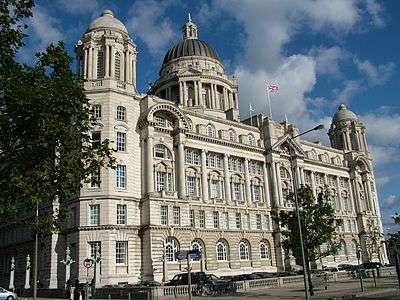
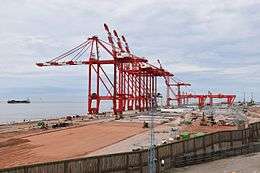
Garston Docks, which are in the city of Liverpool, are not a part of the Port of Liverpool. The working docks are operated by Mersey Docks and Harbour Company, the docks to the south of the Pier Head are operated by the Canal & River Trust, the successor to former operator British Waterways.
History
Liverpool's first dock was the world's first enclosed commercial dock, the Old Dock, built in 1715. The Lyver Pool, a tidal inlet in the narrows of the estuary, which is now largely under the Liverpool One shopping centre, was converted into the enclosed dock. Further docks were added and eventually all were interconnected by lock gates, extending 7.5 miles (12.1 km) along the Liverpool bank of the River Mersey. From 1830 onwards, most of the building stone was granite from Kirkmabreck near Creetown, Scotland.[1]
The interconnected dock system was the most advanced port system in the world. The docks enabled ship movements within the dock system 24 hours a day, isolated from the high River Mersey tides. Parts of the system are now a World Heritage Site.[2]
From 1885 the dock system was the hub of a hydraulic power network that stretched beyond the docks.
Most of the smaller south end docks were closed in 1971 with Brunswick Dock remaining until closure in 1975. Many docks have been filled in to create land for buildings: at the Pier Head, an arena at Kings Dock, commercial estates at Toxteth and Harrington Docks and housing at Herculaneum Dock. In the north, some branch docks have been filled in to create land. Sandon and Wellington Docks have been filled in and are now the location of a sewage works. Most of Hornby Dock was filled in to allow Gladstone Dock's coal terminal to expand.
The largest dock on the dock network, Seaforth Dock, was opened in 1972 and deals with grain and containers, accommodating what were the largest containers ships at that time.
Both White Star Line and Cunard Line were based at the port. It was also the home port of many great ships, including RMS Baltic and the ill-starred Tayleur, MV Derbyshire, HMHS Britannic, RMS Lusitania and the RMS Titanic.
In 1972 Canadian Pacific unit CP Ships were the last transatlantic line to operate from Liverpool. In 2004 UNESCO announced Liverpool Maritime Mercantile City.
Port statistics
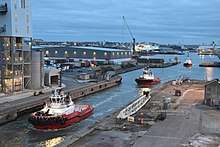
In 2017 Liverpool was the United Kingdom's fourth largest port by tonnage of freight, handling 32.5 million tonnes.[3]
| Product | 2004 | 2003 | 2002 | 2001 |
|---|---|---|---|---|
| Grain | 2,289,000 tonnes | 2,377,000 tonnes | 2,360,000 tonnes | 2,455,000 tonnes |
| Timber | 295,000 tonnes | 391,000 tonnes | 406,000 tonnes | 452,000 tonnes |
| Bulk liquids | 774,000 tonnes | 727,000 tonnes | 788,000 tonnes | 707,000 tonnes |
| Bulk cargo | 6,051,000 tonnes | 6,296,000 tonnes | 5,572,000 tonnes | 5,026,000 tonnes |
| Oil Terminal | 11,406,000 tonnes | 11,406,000 tonnes | 11,604,000 tonnes | 11,236,000 tonnes |
| General cargo | 374,000 tonnes | 556,000 tonnes | 468,000 tonnes | 514,000 tonnes |
| Total | 32,171,000 tonnes | 31,753,000 tonnes | 30,564,000 tonnes | 30,501,000 tonnes |
| Passengers | 720,000 | 734,000 | 716,000 | 654,000 |
| Containers | 616,000 | 578,000 | 535,000 | 524,000 |
| RoRo (car ferry) | 513,000 | 476,000 | 502,000 | 533,000 |
Marina
Liverpool Marina is in Coburg Dock and has 340 berths.
Cruise terminal
.jpg)
Cruise ships once sailed from Langton Dock, part of the enclosed north docks system. Departures and arrivals were subject to tides. Cruise ships returned to Liverpool's Pier Head in 2008, berthing at a newly constructed cruise terminal, enabling departures and arrivals at any time. Until 2012, any cruises beginning in Liverpool still departed from Langton Dock but, since 2012, the terminal has been used as the start and end of voyages, and not merely a stop-off point.[4] This led to a dispute with Southampton due to the large public subsidy provided for the new terminal,[5] which Liverpool City Council has agreed to repay.[6]
Ships which have called at Liverpool Cruise Terminal include RMS Queen Elizabeth 2 (QE2), Grand Princess, Caribbean Princess and RMS Queen Mary 2. A number of large Royal Navy vessels, such as HMS Illustrious and HMS Ark Royal, have also visited the terminal.
Rail connections
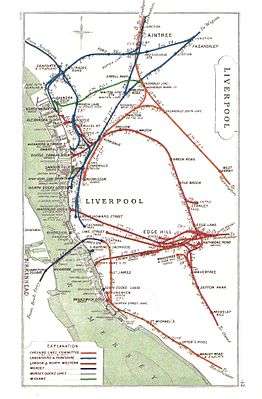
At one point the Mersey Docks and Harbour Company freight railway totalled 104 mi (167 km) of rail line, with connections to many other railways. A section of freight rail line ran under the Liverpool Overhead passenger railway, with trains constantly crossing the Dock Road from the docks into the freight terminals. Today, only the Canada Dock branch line is used to serve the docks, using diesel locomotives.
The first rail link to the docks was the construction of the 1830 Park Lane railway goods station opposite the Queens Dock in the south of the city. The terminal was accessed via the 1.26 mi (2.03 km) Wapping Tunnel from Edge Hill rail junction in the east of the city. The station was demolished in 1972. The tunnel is still intact.
Until 1971, Liverpool Riverside railway station served the liner terminal at the Pier Head. Today, for passengers disembarking from the new cruise terminal, city centre circular buses call at the terminal directly, while Moorfields and James Street are the nearest Merseyrail stations.
On the opposite side of the river, the Birkenhead Dock Branch served the docks between 1847 and 1993. This route remains intact, albeit disused.
Quotes about Liverpool docks
- 'For more than six weeks, the ship Highlander lay in Prince's Dock; and during that time, besides making observations upon things immediately around me, I made sundry excursions to the neighbouring docks, for I never tired of admiring them.
- Previous to this, having only seen the miserable wooden wharves, and slip-shod, shambling piers of New York, the sight of these mighty docks filled my young mind with wonder and delight...
- In Liverpool, I beheld long China walls of masonry; vast piers of stone; and a succession of granite-rimmed docks, completely inclosed, and many of them communicating, which almost recalled to mind the great American chain of lakes: Ontario, Erie, St. Clair, Huron, Michigan, and Superior. The extent and solidity of these structures, seemed equal to what I had read of the old Pyramids of Egypt...
- For miles you may walk along that river-side, passing dock after dock, like a chain of immense fortresses:—Prince's, George's, Salt-House, Clarence, Brunswick, Trafalgar, King's, Queen's, and many more.'
- Herman Melville, Redburn - his first voyage, 1849
- It is a region, this seven-mile sequence of granite-lipped lagoons, which is invested ... with some conspicuous properties of romance; and yet its romance is never of just that quality one might perhaps expect ... Neither of the land nor of the sea, but possessing both the stability of the one and the constant flux of the other—too immense, too filled with the vastness of the outer, to carry any sense of human handicraft—this strange territory of the Docks seems, indeed, to form a kind of fifth element, a place charged with daemonic issues and daemonic silences, where men move like puzzled slaves, fretting under orders they cannot understand, fumbling with great forces that have long passed out of their control ...
- Walter Dixon Scott, Liverpool, 1907[7]
- ...Liverpool is the biggest port ... there was something to see from Dingle up to Bootle, and as far again as Birkenhead on the other side. Yellow water, bellowing steam ferries, white trans-atlantic liners, towers, cranes, stevedores, skiffs, shipyards, trains, smoke, chaos, hooting, ringing, hammering, puffing, the ruptured bellies of the ships, the stench of horses, the sweat, urine, and waste from all the continents of the world ... And if I heaped up words for another half an hour, I wouldn't achieve the full number, confusion and expanse which is called Liverpool.
- Karel Čapek, Letters from England, 1924[7]
- ...Old photographs and even the print of Liverpool Docks as seen from the overhead railway would fail to convey the powerful reality of the Port of Liverpool in the 1950s. This was at the time when every berth had a ship alongside, vessels were waiting off the Port to enter, and they were waiting off the locks on both sides of the river. There were seemingly endless queues of lorries on the Dock Road stretched as far as the eye could see. Delivering exports right up to closing day.
- Francis Major, Ports of Liverpool,The Memoir Club
Image gallery
- 1909 maps
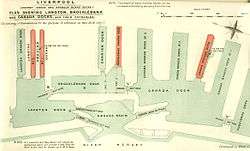
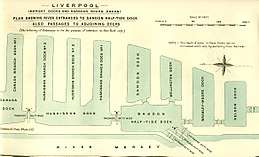
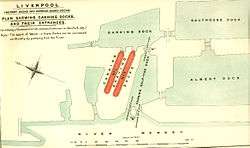
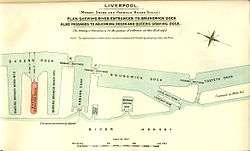

- Modern images

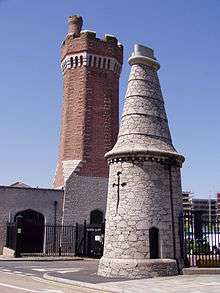
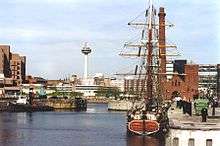





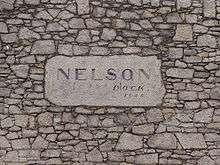





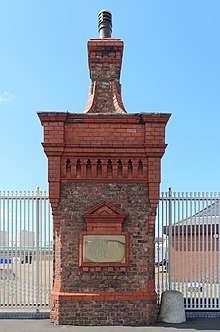

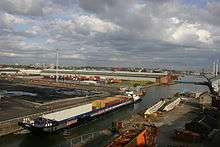




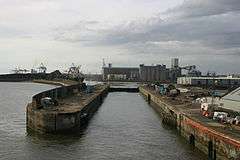
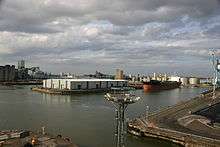
.jpg)
See also
- Isle of Man Steam Packet
- List of Liverpool Docks
- Twelve Quays
- Port of Liverpool Building
- Architecture of Liverpool
References
- "Kirkmabreck Quarry - The History". dalbeattie.com. Retrieved 25 November 2015.
- "Liverpool – Maritime Mercantile City". UNESCO. Retrieved 12 June 2008.
- (PDF) https://assets.publishing.service.gov.uk/government/uploads/system/uploads/attachment_data/file/762200/port-freight-statistics-2017.pdf. Retrieved 3 February 2019. Missing or empty
|title=(help) - "First cruise liner since 1972 leaves Liverpool". BBC. 29 May 2012. Retrieved 19 July 2012.
- "Southampton's battle plans drawn up for cruise terminal dispute with Liverpool". Southern Daily Echo. 5 August 2011. Retrieved 23 September 2011.
- "Liverpool cruise terminal building begins". BBC. 22 March 2012. Retrieved 19 July 2012.
- "Shifted tideways: Liverpool's changing fortunes". Architectural Review. 2008.
External links
- Port of Liverpool Official Website
- UKHO nautical charts of Liverpool Docks and approaches via Queens and Crosby Channels
- 'Liverpool: The docks', A History of the County of Lancaster: Volume 4 (1911), pp. 41-43. Date accessed: 16 November 2009.
- The Port of Liverpool In Camera
- Historic map of railways in Liverpool
- Select Committee on Environment, Transport and Regional Affairs: Memorandum by Merseytravel
